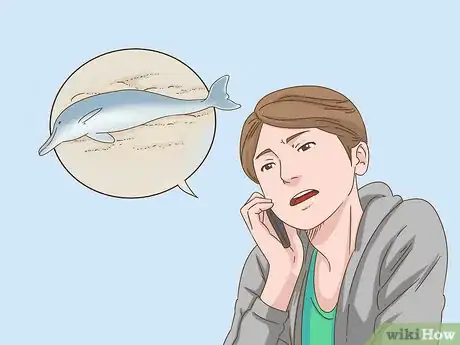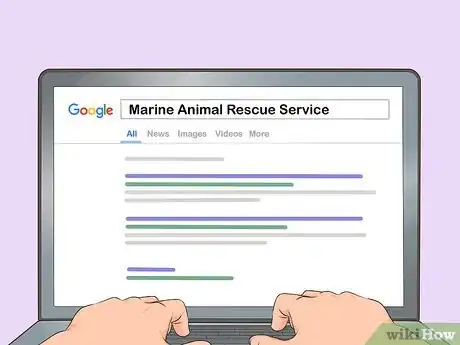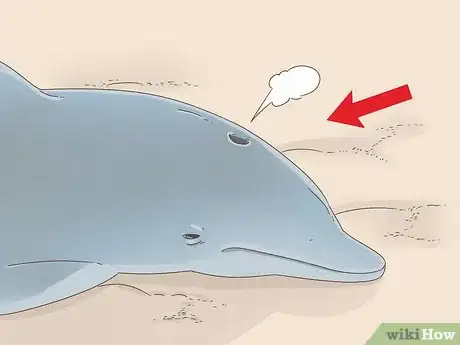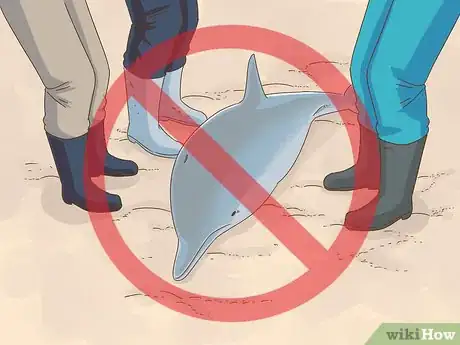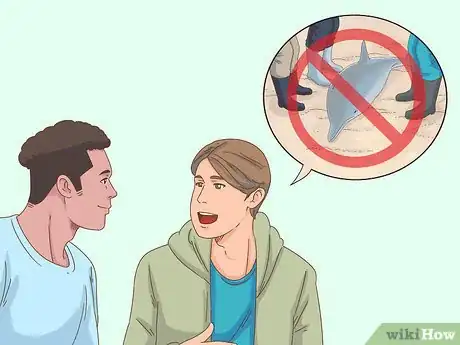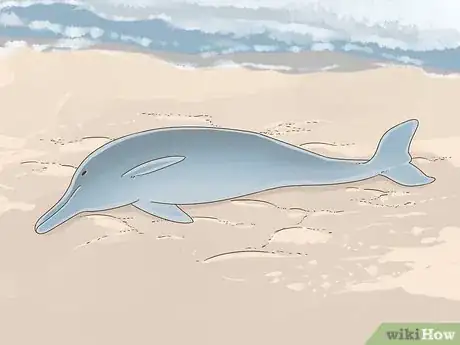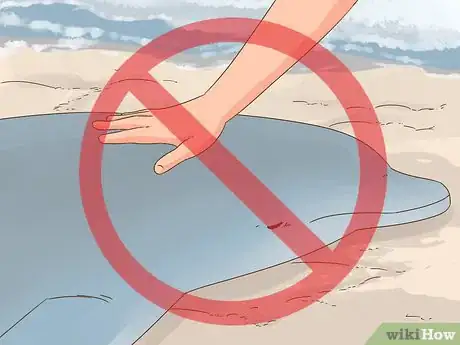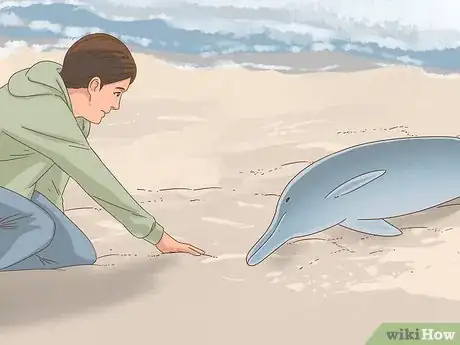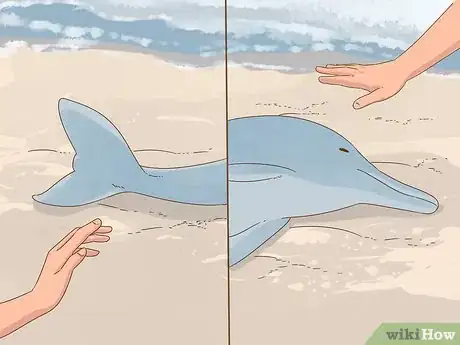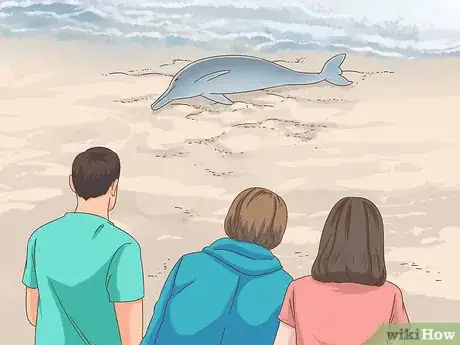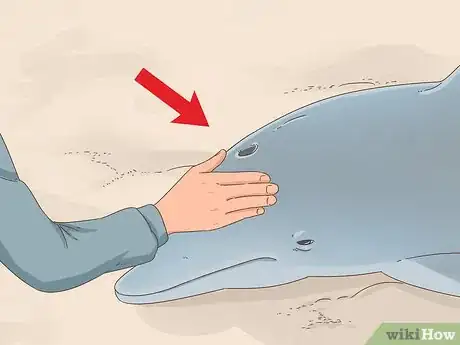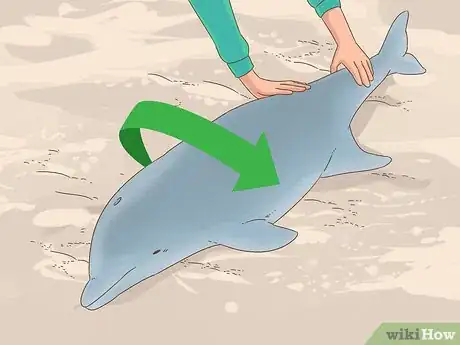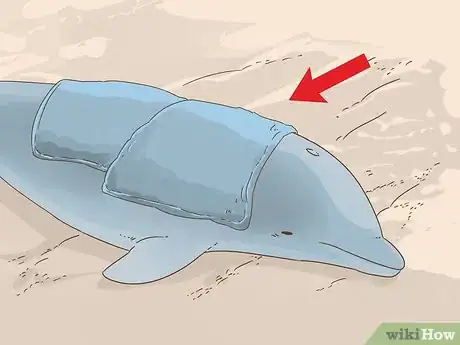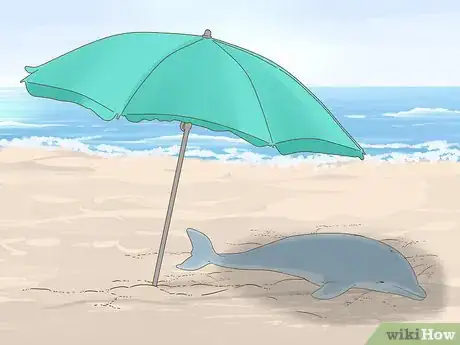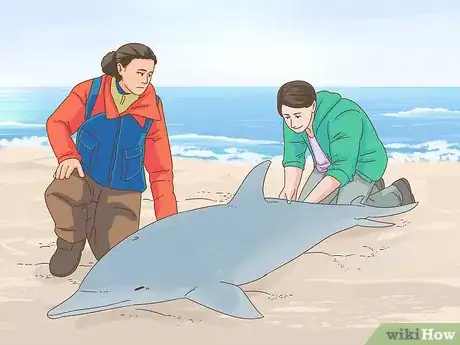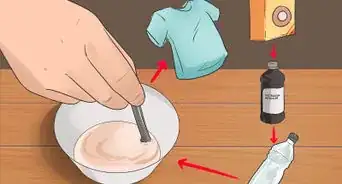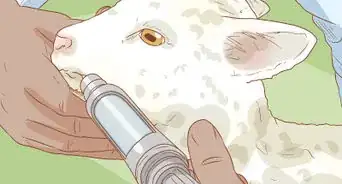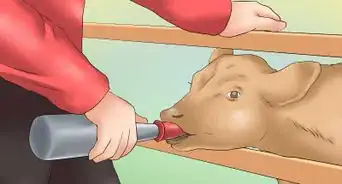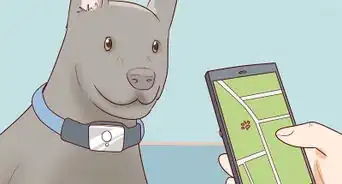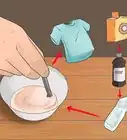This article was co-authored by wikiHow Staff. Our trained team of editors and researchers validate articles for accuracy and comprehensiveness. wikiHow's Content Management Team carefully monitors the work from our editorial staff to ensure that each article is backed by trusted research and meets our high quality standards.
This article has been viewed 31,219 times.
Learn more...
Have you ever been on vacation at the beach and seen a pod of dolphins swimming close to the shoreline? Although it’s rare, sometimes a dolphin will get separated from its pod and beach itself on the nearest shore. This is called stranding. Bottlenose dolphin strandings have been on the rise since 2013 on the US east coast, from New York to Florida, so knowing what to do if you see a stranded dolphin is actually important. Follow these steps to help a dolphin in distress.
Steps
Sending for Help
-
1Call the authorities. The most important thing about a dolphin stranding is keeping everyone—people and dolphin—safe. The best way to do this is to report the dolphin’s presence to the local police. They will know what experts to contact to get proper care for the dolphin.
- The police may come to the scene to barricade the animal in order to prevent it from spreading disease. The dolphin may not have stranded itself because it’s sick, but if it is, the disease could pass to humans through contact.
-
2Look up the nearest marine animal rescue service. Although the police will probably do this for you, it’s a good idea to report what you see directly. Do an internet search for “marine animal rescue service” or “regional stranding network” with your location to find one.
- Every coastal region of the United States has a volunteer stranding network. The National Oceanic and Atmospheric Administration (NOAA) connects with these networks to save stranded mammals of all kinds, as well as turtles.
- Make note of the dolphin’s physical characteristics so that the marine rescue agency you contact can bring the right equipment.[1]
Advertisement -
3Make sure it’s alive. Even if the mammal is dead, the body needs to be removed from the beach to protect swimmers and other beach-goers. Calling the authorities is the right thing to do whether it’s alive or dead.
- Watch the blowhole. Dolphins breathe out of this hole, not their mouths, so keep an eye on the blowhole for exhalation.
- You can do this without touching the dolphin. Most dolphins can hold their breath for a long time, so wait about 20 minutes for breathing or movement. If there isn't any, the dolphin is probably dead.[2]
- If the dolphin is dead, protocols like staying quiet do not apply, but staying back and not touching the dolphin become even more important in order to prevent the spread of disease.
-
4Keep people back. If you are the first responder to a stranded dolphin, it’s your job to coordinate the safety of both those near the dolphin and the dolphin itself. The most important thing for the safety of both is no contact. Keep people, dogs, and anything else at least 50 feet away from the dolphin.[3] Ask them to keep quiet so the dolphin doesn’t get upset.
- Tell any crowd that has gathered what you're doing in a calm, low voice. Explain that the dolphin is probably scared and to please keep their voices down.
- If you don’t feel comfortable taking charge, quickly find someone who will step in.
-
5Recruit others to help protect the dolphin. Once people have moved away from the dolphin, recruit others to assist you. The more people are in the crowd, the more help you will need, especially if there are young children and pets present.
Being Careful
-
1Leave the dolphin where it is. Trying to move a dolphin will make its current injuries worse, or injure it in a new way. The best thing for the dolphin is to let it lie still until professionals arrive with proper equipment.
-
2Understand the danger of illness. Marine animals carry diseases. Although scientists are not completely sure why dolphins strand themselves, one theory is that it is most likely due to disease. Such diseases can easily pass to humans, so the best thing to do is not touch the dolphin.
- Illness in wild animals is especially a concern for young children, whose immune systems are not as strong as those of adults. Take special care that kids do not touch the dolphin.
- If you do come in contact with a dolphin, immediately wash your hands and skin.
-
3Use extreme caution. A stranded dolphin is a wild animal. It may feel threatened by your presence and choose to attack those near it.
- Although dolphins usually defend themselves by swimming in packs of about 12 dolphins (called pods), they can do some damage on their own with their strong beaks and tails.
-
4Stand away from the tail and face. Dolphins are strong, muscular creatures. Make sure that if you are standing near, or working with, a stranded dolphin, be far from the face and tail.
- A dolphin’s most powerful feature is its tail. Do not hold or even touch the tail.
- By shaking its head from side to side, a dolphin can strike anyone within range. Make sure anyone who is authorized to help the dolphin stands clear of the face and the range of its snout.
Waiting for Help to Arrive
-
1Continue to keep people back. It may take some time for the authorities to arrive. While you wait, use your volunteers and keep the crowd at least 50 feet away from the dolphin. Remember to have people keep their volume down so the dolphin is kept as calm as possible.
- Explain to everyone that the dolphin can both hurt people standing too close and spread disease if touched. This explanation will more than likely keep people from ignoring you.
- If you do see someone touch the dolphin, make sure they wash their skin immediately.
- If the dolphin hurts someone, call 911 again to get an ambulance ready.
-
2Check the location of the blowhole. A dolphin’s blowhole is located on the top of its head. Any debris or blockage of this hole—even from water—can cause suffocation.
- Never get water or sand anywhere near a dolphin's blowhole. Just like a human can drown if too much water comes into our mouths, dolphins can drown from water blocking their blowholes.
-
3Roll the dolphin onto its belly if needed. If the dolphin is lying on its side or back, this means the blowhole is at risk of being blocked or is blocked entirely, whether by sand or water. Since this will cause suffocation, there is an immediate need for someone to roll the dolphin onto its stomach.
- Only proceed with this step if you have assistance and are confident you know what you’re doing![4]
- Do not pull on the fins or tail, or try to push the dolphin back into the water.
-
4Douse the dolphin in water. Soak towels in water and lay them over the dolphin. If someone has a bucket, they can pour water over the dolphin’s back, making sure not to get water near the blowhole.
- You can cover the dolphin with a wet towel below its blow hole if you cut a slit for the dorsal fin, which is the fin on the dolphin’s back. Fit the towel very carefully over the dorsal fin.
-
5Get shade for the dolphin. If the dolphin is in direct sunlight, create shade for it with a beach umbrella or other device, making sure it doesn’t come in contact with the dolphin at any time.
-
6Dig holes under the pectoral fins. This will make the dolphin more comfortable as it is not used to being on land. The pectoral fins, also known as flippers, are not made for flat surfaces.
- You can also dig a hole under the chest and fill it with water. This will not only keep the dolphin wet, but it will support its chest while relieving pressure on the lungs and flippers.
-
7Get out of the way of professionals. When the authorities arrive, get out of their way, and help the crowd stay out of the way too. The professional marine mammal rescuers that have arrived know how to take care of the dolphin better than you do, so making sure no one interferes is the best thing you can do for the dolphin.
-
8Prepare for death. Even with your best efforts, if a live stranded dolphin is already injured, dehydrated, or very sick, it may not survive its rescue. This may be especially difficult for children who are observing the rescue to cope with.
Community Q&A
-
QuestionAre dolphins becoming extinct?
 Community AnswerMany dolphin species are endangered due to fishing nets, overfishing and pollution. Some river dolphin species are speculated to have less than a few hundred left in the wild.
Community AnswerMany dolphin species are endangered due to fishing nets, overfishing and pollution. Some river dolphin species are speculated to have less than a few hundred left in the wild. -
QuestionWhat should I do if the dolphin isn't breathing?
 Community AnswerCall for help and get a vet. Make sure to keep the dolphin wet with water from the sea.
Community AnswerCall for help and get a vet. Make sure to keep the dolphin wet with water from the sea. -
QuestionWhat do I do if I find a dolphin on my car after a hurricane?
 Community AnswerAvoiding the mouth, check for signs of life, such as movement and air coming in and out of the blowhole. Once you are sure that the dolphin is alive, you should call the authorities and they will take care of the dolphin. You should also call your insurance and get your car taken care of, too.
Community AnswerAvoiding the mouth, check for signs of life, such as movement and air coming in and out of the blowhole. Once you are sure that the dolphin is alive, you should call the authorities and they will take care of the dolphin. You should also call your insurance and get your car taken care of, too.
Warnings
- Be aware of your surroundings at all times when dealing with a stranded dolphin. This is to keep you from getting hurt in case they thrash their tail or face in self defense.⧼thumbs_response⧽
- Don’t forget that if a dolphin is sick, it can pass this disease on to humans and pets. Do not touch the dolphin. If contact does happen, wash your skin (or the fur of your pet) immediately.⧼thumbs_response⧽
References
- ↑ http://www.marinemammalcenter.org/what-we-do/rescue/what-we-do-if-you-find-a.html
- ↑ http://www.whalefacts.org/how-do-dolphins-breathe/
- ↑ http://www.marinemammalcenter.org/what-we-do/rescue/what-we-do-if-you-find-a.html
- ↑ http://us.whales.org/issues/what-to-do-if-you-find-live-stranded-whale-or-dolphin
About This Article
You can save a stranded dolphin by immediately calling the police or a local marine animal rescue service that’s trained to deal with stranded animals. Once you call for help, ask anyone else near the dolphin to stay back to protect themselves, since dolphins can injure people and spread disease. Additionally, you should make sure no one tries to move the dolphin, which could end up aggravating its injuries. While you wait for help to arrive, you can carefully pour some water on the dolphin’s back to keep it wet, taking care to avoid the blowhole so it doesn’t suffocate. To learn how to check to see if the dolphin is alive, read on.
